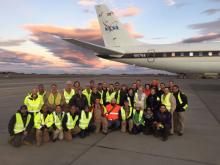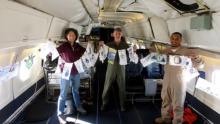Update
Now archived! PolarConnect event with Maggie Kane from Punta Arenas, Chile and Project Manager John Woods from Antarctica. You can access this and other events on the PolarConnect Archives site: https://www.polartrec.com/polar-connect/archive
What Are They Doing?
 NASA's P-3 Orion aircraft. Photo by Mark Buesing.
NASA's P-3 Orion aircraft. Photo by Mark Buesing.
IceBridge, a six-year NASA mission, is the largest airborne survey of Earth's polar ice ever conducted. IceBridge uses a highly specialized fleet of research aircraft and the most sophisticated science instruments ever assembled to characterize yearly changes in thickness of sea ice, glaciers, and ice sheets in the Arctic and Antarctic. The research team will experience first-hand the excitement of flying a large research aircraft over the Greenland Ice Sheet. While in the air they will record data on the thickness, depth, and movement of ice features, resulting in an unprecedented three-dimensional view of ice sheets, ice shelves, and sea ice. Operation IceBridge began in 2009 to bridge the gap in data collection after NASA's ICESat satellite stopped functioning and when the ICESat-2 satellite becomes operational in 2016, making IceBridge critical for ensuring a continuous series of observations of polar ice. IceBridge flies over the Arctic and Antarctic every year — in the Arctic from March to May and the Antarctic in October and November. By comparing the year-to-year readings of ice thickness and movement both on land and on the sea, scientists can look at the behavior of the rapidly changing features of the polar ice and learn more about the trends that could affect sea-level rise and climate around the globe. More information about IceBridge can be found at the NASA project website. http://www.nasa.gov/icebridge
Where Are They?
 Punta Arenas, Chile. Photo by Amber Lancaster.
Punta Arenas, Chile. Photo by Amber Lancaster.
Punta Arenas is a city near the tip of Chile's southernmost Patagonia region. Located on the Strait of Magellan, which connects the Atlantic and Pacific oceans, it's often used as base for excursions to the surrounding wilderness and Antarctica. The Plaza Muñoz Gamero has a memorial to explorer Ferdinand Magellan, and the Museo Nao Victoria features a replica of one of his galleons. The research team will be based out of a local hotel in downtown Punta Arenas, and the plane will be based out of the International Airport.
Latest Journals

John Woods is a native of Lavallette, NJ and currently resides in Annapolis, MD with his wife and 3 kids. He studied Oceanography at the United States Naval Academy and obtained his master’s degree in Oceanography and Meteorology at the Naval Postgraduate School in Monterey, CA. John served on active duty in the U.S. Navy as a Surface Warfare Officer on the USS Cleveland (LPD-7) deploying to the Persian Gulf two times, and as a Meteorology and Oceanography (METOC) Officer at the U.S. Naval Ice Center. His final tour was back at the U.S. Naval Academy teaching in the Oceanography Department where he created the Polar Science Program. This assignment first introduced him to Polar Operations and Logistics leading 4 different learning activities to the Arctic Region. After transitioning to the Navy Reserves, he was the Project Manager for NASA's Operation IceBridge, successfully executing over a dozen science campaigns to both the Polar North and South. Most recently John was a physical scientist for NOAA at the U.S. National Ice Center until recently transitioning back to the Navy in his current position with the Office of Naval Research, International Engagement Office focusing on collaborations with polar nations.





